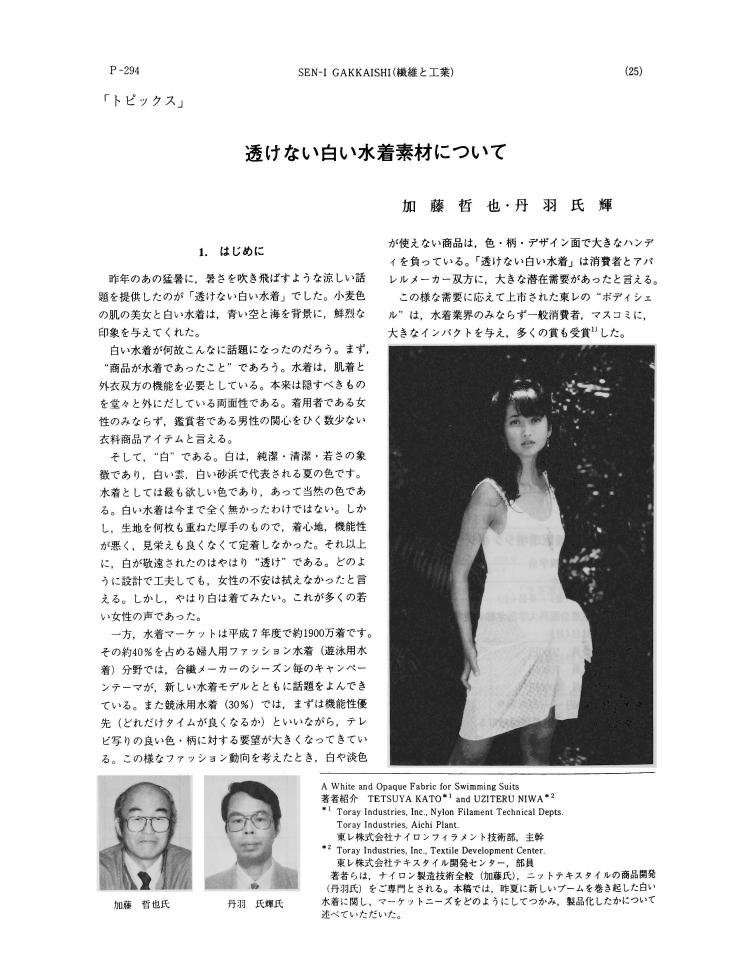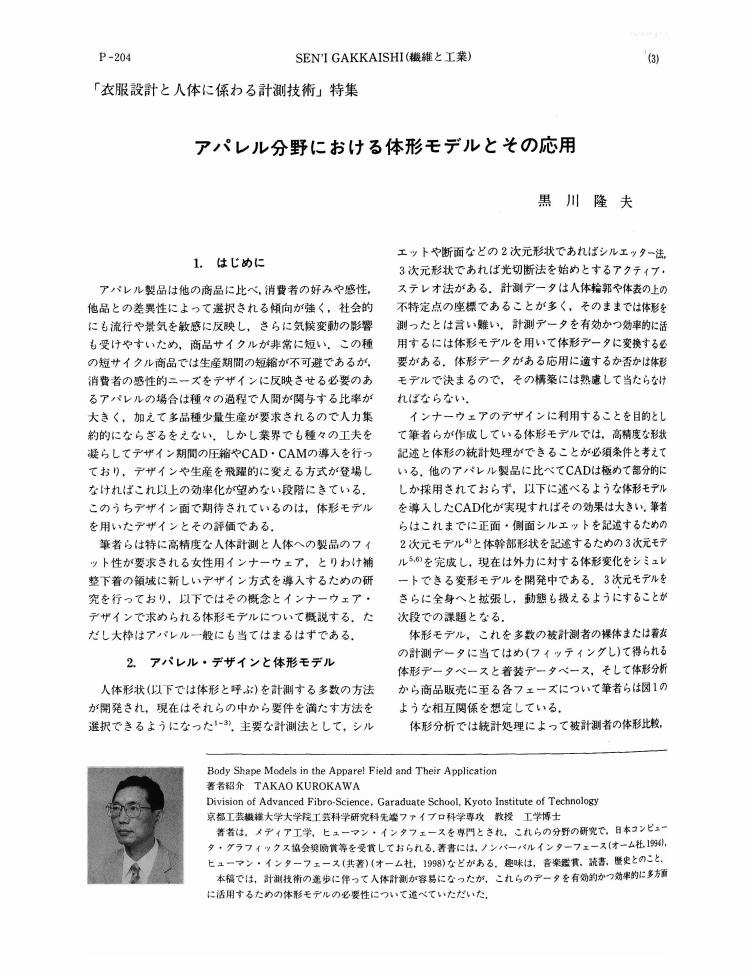60 0 0 0 OA 静電フィルターの機能と応用
- 著者
- 木村 一志
- 出版者
- The Society of Fiber Science and Technology, Japan
- 雑誌
- 繊維学会誌 (ISSN:00379875)
- 巻号頁・発行日
- vol.51, no.8, pp.P332-P339, 1995-08-10 (Released:2008-06-30)
- 参考文献数
- 45
- 被引用文献数
- 4 3
20 0 0 0 OA 透けない白い水着素材について
- 著者
- 加藤 哲也 丹羽 氏輝
- 出版者
- The Society of Fiber Science and Technology, Japan
- 雑誌
- 繊維学会誌 (ISSN:00379875)
- 巻号頁・発行日
- vol.51, no.7, pp.P294-P297, 1995-07-10 (Released:2008-06-30)
- 参考文献数
- 2
- 被引用文献数
- 1
19 0 0 0 OA 繊維とエアフィルタ用不織布
- 著者
- 木場 昭人
- 出版者
- The Society of Fiber Science and Technology, Japan
- 雑誌
- 繊維学会誌 (ISSN:00379875)
- 巻号頁・発行日
- vol.51, no.5, pp.P206-P210, 1995-05-10 (Released:2008-06-30)
- 参考文献数
- 2
8 0 0 0 OA 二酸化炭素の電解還元による再資源化技術
- 著者
- 堀 善夫
- 出版者
- The Society of Fiber Science and Technology, Japan
- 雑誌
- 繊維学会誌 (ISSN:00379875)
- 巻号頁・発行日
- vol.48, no.1, pp.P38-P42, 1992-01-10 (Released:2008-11-28)
- 参考文献数
- 2
- 被引用文献数
- 1
8 0 0 0 OA 国宝・獅子狩文錦-シルクロードの回想-
- 著者
- 書上 誠之助
- 出版者
- The Society of Fiber Science and Technology, Japan
- 雑誌
- 繊維学会誌 (ISSN:00379875)
- 巻号頁・発行日
- vol.38, no.5, pp.P234-P242, 1982-05-10 (Released:2008-11-28)
- 参考文献数
- 20
- 被引用文献数
- 1
5 0 0 0 OA プラスチック材料の耐候性
- 著者
- 野中 矩仁
- 出版者
- The Society of Fiber Science and Technology, Japan
- 雑誌
- 繊維学会誌 (ISSN:00379875)
- 巻号頁・発行日
- vol.40, no.7, pp.P493-P503, 1984-07-10 (Released:2008-11-28)
- 参考文献数
- 23
- 被引用文献数
- 1 1
4 0 0 0 OA 布の乾燥速度について
- 著者
- 山田 晶子
- 出版者
- The Society of Fiber Science and Technology, Japan
- 雑誌
- 繊維学会誌 (ISSN:00379875)
- 巻号頁・発行日
- vol.41, no.6, pp.T248-T254, 1985-06-10 (Released:2008-11-28)
- 参考文献数
- 9
In order to understand the drying process of fabrics, drying experiment in household manner was conducted at five atomospheric conditions. (10 and 20°C at 65% RH, and 30°C at 40, 65 and 90% RH)Other experiments on 18 samples of different fabrics were conducted in a condition of 30°C at 40% RH.The following conclusions were obtained.1. Evaporation rate of water (K1 [g/cm2•min]) in the constant rate period is mainly determined by the difference between the temperatures of air and wet bulb (ta and tw), although it changes somewhat by the difference between fabrics.In the constant rate period, the water in the fabric comes to the surface so rapidly by capillary migration, that the fabric surface is almost saturated with water vapor, and evaporation of water continues in each constant rate of each fabrics.Hygroscopic, roughly wovened, napped fabric has a wide surface for evaporation, and water evaporates rapidly from these fabrics than from other hydrohobic smooth surfaced fabrics in the constant rate period.2. The end of the constant rate period where the critical moisture content (C. M. C.) is defined, appeared to be the final point where the fabric surface is still saturated with water vapor.Higher rate of water transfer from the fabric to the air in the constant rate period, and slower capillary migration in the fabric are main factors for higher C. M. C.3. The drying rate constant (K2 [1/min]) in the falling rate period is greater for hydrohobic fabrics, and for thinner fabrics. Also, for hygroscopic fabrics with smaller volume fraction of fiber, the rate constant K2 is greater.
4 0 0 0 OA セルロースの光崩壊に関する研究
- 著者
- 鯨井 忠五
- 出版者
- The Society of Fiber Science and Technology, Japan
- 雑誌
- 繊維学会誌 (ISSN:00379875)
- 巻号頁・発行日
- vol.22, no.2, pp.84-89, 1966-02-10 (Released:2008-11-28)
- 参考文献数
- 33
- 被引用文献数
- 1 2
Reaction mechanisms of photodegradation of cellulose have been proposed under consideration of the experimental facts obtained in report (1) to (VI). The degradation mechanisms are different according to wavelength of light used in irradiation experiments, i.e., (1) on irradiation by λ 1850A, the photochemically primary dissociation occurs in cellulose by its strong absorption of light of this wavelength, the reaction being independent of the presence of oxygen. At the comparatively early period of exposure, direct scission of glucosidic linkage predominates but on prolonged exposure, the formation of 2, 3- dialdehyde by splitting off H-atoms from secondary carbon atoms of the molecule occurs, the latter being easily degradated by alkali medium such as cuam solution. (2) On the other hand, coexistence of oxygen is indispensable to the photodegradation by λ 2537 A irradiation. In this case, absorption matter of λ 2537A is oxygen molecule (Herzberg band), because cellulose is transparent against visible and ultraviolet light having a wavelength longer than λ 2000 A. The main initial step of this reaction is as follows: the excited oxygen molecule thus formed abstracts a hydrogen atom from 1-carbon atom of pyranose ring to form cellulose radical and this reacts with oxygen and other cellulose molecule to produce cellulose peroxide as can be seen in the case of autoxidation of ordinary hydrocarbons. This peroxide is then decomposed photochemically and at the same time, the chain is broken into two chain fragments, accompanying the formation of δ-lactone as the end group of one fragment. The end group of the other fragment has the same configuration as ordinary cellulose molecule. The lactone end group is further hydrolyzed photochemically under the trace of water to form hydroxy-carboxilic acid end group.The quantum yields of each wavelength are calculated and the following values are obtained: γ (1850A)=1×10-2, γ(2537A)=0.5×10-2. Both values are far smaller than unity. The cause of these small values may be attributed mainly to the cristalinity of cellulose fine structure, i.e., in the case of λ 1850A irradiation, recombination of two dissociated chain fragments occurs in crystal region according to Franck-Rabinowitch theory, while in the case of λ 2537A irradiation, diffusion of oxygen molecule, necessary for photoxidation, into this region are difficult and in consequence, photoxidative degradation is inhibited. In both cases, role of crystal region reduces the quantum yield.
4 0 0 0 OA 衣料サイズの変遷と新JIS規格の概要
- 著者
- 三吉 満智子
- 出版者
- The Society of Fiber Science and Technology, Japan
- 雑誌
- 繊維学会誌 (ISSN:00379875)
- 巻号頁・発行日
- vol.54, no.4, pp.P109-P115, 1998-04-10 (Released:2008-06-30)
- 参考文献数
- 8
- 著者
- Yoko Nomura Toshio Sasaki Hyung-Been Kang Ryuichi Suwa
- 出版者
- The Society of Fiber Science and Technology, Japan
- 雑誌
- Journal of Fiber Science and Technology (ISSN:21897654)
- 巻号頁・発行日
- vol.73, no.11, pp.317-326, 2017-11-10 (Released:2017-11-28)
- 参考文献数
- 41
- 被引用文献数
- 1
Okinawa Island is part of the Ryukyu Islands located in southern Japan. Basho-fu is a unique and traditional Okinawan textile made from the banana plant Itobasho. The traditional production process of Bashofu has not been well studied scientifically. In this study, materials from the traditional degumming process (Udaki) of Basho-fu were characterized by morphological observation and other analytical instruments (FT-IR and XRD). The fiber materials degummed by the traditional and the modern laboratory methods were compared. The vascular bundles of the main component of Basho-fu fibers were conserved in the materials processed by the two degumming methods. However the FT-IR study indicated that the traditional method was milder than the laboratory process. The results scientifically confirms that the delicate traditional degumming step is a crucial process in the production of the fine Basho-fu textiles.
3 0 0 0 OA 万葉の染め
- 著者
- 三石 賢
- 出版者
- The Society of Fiber Science and Technology, Japan
- 雑誌
- 繊維学会誌 (ISSN:00379875)
- 巻号頁・発行日
- vol.50, no.10, pp.P580-P581, 1994-10-10 (Released:2008-11-28)
3 0 0 0 OA メルトブロ-不織布の特性とその応用
- 著者
- 小西 武四
- 出版者
- The Society of Fiber Science and Technology, Japan
- 雑誌
- 繊維学会誌 (ISSN:00379875)
- 巻号頁・発行日
- vol.49, no.2, pp.P56-P60, 1993-02-10 (Released:2008-11-28)
- 参考文献数
- 5
3 0 0 0 OA 導電性高分子を用いた人工筋肉
- 著者
- 金藤 敬一
- 出版者
- The Society of Fiber Science and Technology, Japan
- 雑誌
- 繊維学会誌 (ISSN:00379875)
- 巻号頁・発行日
- vol.50, no.12, pp.P628-P631, 1994-12-10 (Released:2008-11-28)
- 参考文献数
- 17
2 0 0 0 OA 加齢と皮膚感覚
- 著者
- 山野 井昇
- 出版者
- The Society of Fiber Science and Technology, Japan
- 雑誌
- 繊維学会誌 (ISSN:00379875)
- 巻号頁・発行日
- vol.54, no.7, pp.P237-P241, 1998-07-10 (Released:2008-06-30)
- 参考文献数
- 5
2 0 0 0 OA アクリル重合体溶液における混合溶剤の影響
- 著者
- 内山 修一
- 出版者
- The Society of Fiber Science and Technology, Japan
- 雑誌
- 繊維学会誌 (ISSN:00379875)
- 巻号頁・発行日
- vol.22, no.8, pp.373-378, 1966-08-10 (Released:2008-11-28)
- 参考文献数
- 8
- 被引用文献数
- 1
Viscosities of dilute acrylonitrile polymer solution containing various kinds of non-solvent were measured at 30°C and 50°C (in the case of acetone 30°C and 40°C). Intrinsic viscosity [η] and Huggins' constant were calculated and viscosity change with time of concentrated polymer solution were measured.The results obtained are as follows:A) In the case of dilute solution, 1) Nitromethane, acetone, n-hexane and tetrahydrofuran (THF) increase [η] but k′ decreases with increasing amount of them and temperature rises. They behave as poor solvents.2) Dioxane does not change [η] and k′ below 5 volume % benzene behaves as good solvent below 10 volume %, however, it behaves as poor solvent above that content.B) In the case of concentrated solution, Concentrated solution containing n-hexane increases viscosity with time and with the increasing amount. Benzene, THF and dioxane do not cause viscosity increase below a certain amount, however, they increase viscosity with time.
2 0 0 0 OA 感性工学とは
- 著者
- 長町 三生
- 出版者
- The Society of Fiber Science and Technology, Japan
- 雑誌
- 繊維学会誌 (ISSN:00379875)
- 巻号頁・発行日
- vol.50, no.8, pp.P468-P472, 1994-08-10 (Released:2008-11-28)
- 参考文献数
- 5
- 被引用文献数
- 4 11
2 0 0 0 OA 繊維製品のCAD/CAM技術の現状と展望
- 著者
- 太田 健一 渋谷 惇夫 今岡 春樹 清水 義雄
- 出版者
- The Society of Fiber Science and Technology, Japan
- 雑誌
- 繊維学会誌 (ISSN:00379875)
- 巻号頁・発行日
- vol.50, no.9, pp.P510-P523, 1994-09-10 (Released:2008-11-28)
- 参考文献数
- 34
- 被引用文献数
- 2 3
2 0 0 0 OA アパレル分野における体形モデルとその応用
- 著者
- 黒川 隆夫
- 出版者
- The Society of Fiber Science and Technology, Japan
- 雑誌
- 繊維学会誌 (ISSN:00379875)
- 巻号頁・発行日
- vol.54, no.6, pp.P204-P208, 1998-06-10 (Released:2008-06-30)
- 参考文献数
- 11
2 0 0 0 OA 白さと日本人の好み
- 著者
- 駒城 素子
- 出版者
- The Society of Fiber Science and Technology, Japan
- 雑誌
- 繊維学会誌 (ISSN:00379875)
- 巻号頁・発行日
- vol.43, no.5, pp.P178-P182, 1987-05-10 (Released:2008-11-28)
- 参考文献数
- 18
- 被引用文献数
- 1 1
- 著者
- 青木 啓
- 出版者
- The Society of Fiber Science and Technology, Japan
- 雑誌
- 繊維学会誌 (ISSN:00379875)
- 巻号頁・発行日
- vol.48, no.6, pp.P336-P338, 1992














